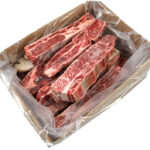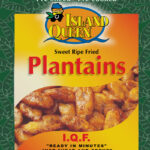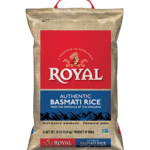BFS is a proud partner with Fresh Point, North America’s largest fresh produce provider. The BFS cold chain for Produce, all Meats, Seafood, Frozen Foods, Cooler Products and Dairy remains unbroken from the farm or factory to the buyer’s door (or to the mailboat), guaranteeing the freshest possible imported produce and perishables.
One super exciting facet of handling fresh produce is the fact that the “cold chain” is now fully acknowledged as being the real deal-breaker or the deal-maker in shipping perishables. Due to the escalating costs involved in growing, shipping, loading, storing, transporting, documenting, etc. of perishables, we no longer can look at the necessity of a strong consistent cold chain as something that we can choose to work with or choose work without. We cannot simply hope that wee can move the product fast enough. Here is a brief read on “Reefer” (Refrigerated Container) background information.
DIDyou know? These days, we see these ocean containers everywhere. On every large and small road, in storage yards, on dock siding, on rural back-roads, atop ships and at the ends of long cables as the gantry raises them and lowers them from pier-to-ship, and from ship-to-pier. Never taking something for granted is a good rule to live by. This incredibly ingenious and globe-changing device makes our world’s goods travel more safely, makes them more accessible, and these containers are improving by leaps-and-bounds in this industry of cold-chain reliance.
Refrigerated Containers – “reefers” – account for a growing share of the refrigerated cargo being transported around the world. In 1980, 33% of the refrigerated transport capacity in maritime shipping was containerized; this share rapidly climbed to 90% in 2010. The structure of global maritime shipping is rapidly adapting to service the reefer trade implying a shift away from specialized ports, or specialized terminals within ports, to standard container terminals. The reefer has become a common temperature-controlled transport unit used to insure load integrity since it can accommodate a wide range of temperature settings and accordingly a wide range of temperature sensitive products. Some now ensure an atmosphere-controlled interior. Also, it is a versatile unit able to carry around 25 tons of refrigerated cargo and is fully compatible with the global inter-modal transport system, which implies a high level of accessibility to markets around the world. About 2.02 million TEU’s of reefers were being used by 2011, which represents about 5% of the global ISO container capacity.
>> While a regular 40 foot container costs around $5,000 to construct, a reefer of the same size is in the range of $30,000. The cost difference is attributed to insulation and the refrigeration unit that keeps the temperature constant. This implies that a reefer has less volume than a regular container of the same size. While a regular 40 foot high cube container can accommodate a volume of 76 cubic meters [2683.91 cubic feet ], a reefer of the same size handles 67 cubic meters [ 2366.08 cubic feet or 12% less ]. This shortcoming is compensated by the heavier loads that are usually carried in reefers.
 Proper air circulation is of paramount importance to maintain the integrity of most refrigerated cargo, as this is critically important for fresh produce loads. Therefore, it is implied that reefers have gratings built into their floor and a clearance of about 15 cm must be kept between the cargo and the ceiling. Attempting to add more volume by floor stacking is an exercise in futility, and is a formula for failure because the floor stacked produce will be unduly and critically chilled, and their direct contact with the specially engineered slotted floor virtually destroys the intended engineered air flow.
Proper air circulation is of paramount importance to maintain the integrity of most refrigerated cargo, as this is critically important for fresh produce loads. Therefore, it is implied that reefers have gratings built into their floor and a clearance of about 15 cm must be kept between the cargo and the ceiling. Attempting to add more volume by floor stacking is an exercise in futility, and is a formula for failure because the floor stacked produce will be unduly and critically chilled, and their direct contact with the specially engineered slotted floor virtually destroys the intended engineered air flow.
Cold air coming out of the refrigeration unit flows through the bottom part of the reefer and as it warms up it climbs towards the ceiling to flow back to the refrigeration unit, usually 0.5°C to 3°C warmer. The heat is the outcome of ambient temperature permeating into the reefer as well as the cooling of the cargo if it was loaded in at a warmer temperature from a non-refrigerated loading dock than the temperature maintained in the reefer. This is particularly the case when ambient temperature is high, for example, in tropical shipping zones. All reefers are usually painted white to increase the albedo, which refers to the share of the incident light being reflected. High albedo implies less solar energy absorbed by the container’s continually exposed outer surface. For instance, a low albedo container can have its internal temperature increase to 50°C when the external temperature reaches 25°C on a sunny day while a high albedo container sees its internal temperature increase to only 38°C under the same conditions.
The refrigeration unit of a reefer requires an electric power source during transportation and at a container yard. For the road transport of a reefer, either a clip-on generator called a “genset” that attaches to the upper front end of a reefer or an “underslung generator” that attaches under a container’s chassis, are used. For modes such as maritime and rail that can carry multiple containers, the capacity of the power system determines the number of reefers that can be carried. Regular container ships have 10 to 20% of their slots adapted to carry reefers, with some ships having up to 25% of their slots being dedicated when servicing routes with a higher intensity of refrigerated cargo. e.g. Latin American exports. The power is directly provided by the ship’s generator.
For rail movements, diesel generators are used to provide power to about 8 reefer containers. It is important to underline that the refrigeration units are designed to maintain the temperature within a prefixed range, not to cool it down. This implies that the rail-bound shipment must be brought to the required temperature before being loaded into a reefer, which requires specialized warehousing and loading / unloading facilities.
Exciting news is that a new generation of reefers is coming online, which are equipped with an array of sensors monitoring effectively the temperature, to modify the internal gas atmosphere of the reefer and shutting the cooling plant when unnecessary. These reefers are obviously more expensive to build and to operate but the advantage to their function is phenomenally exciting. This enables to improve the reliability of temperature control, ship perishables for much longer distances, ensure the quality of these delicate fresh items and extend the autonomy of the reefer. The growth of the intermodal transportation of reefers has increasingly required transport terminals, namely ports, to dedicate a part of their storage yards to reefers. This accounts for between 1% to 5% of the total terminal capacity, but can be higher for trans-shipment hubs or terminals in areas with an important reefer trade. The stacking requirements simply involve having an adjacent power outlet, but the task is more labour intensive as each container must be plugged in and unplugged manually and the temperature to be monitored regularly as it is the responsibility of the terminal operator to insure that the reefers keep their temperature within preset ranges. This may also forbid the usage of an overhead gantry crane implying that the reefer stacking area can be serviced by different yard equipment. Even if reefers involve higher terminal costs, they are very profitable due to the high value commodities they transport. The higher costs of the reefer and the additional equipment and monitoring required involve higher shipping rates. To be profitable, a reefer must be used 4 to 6 times per year as a revenue generating movement.

























